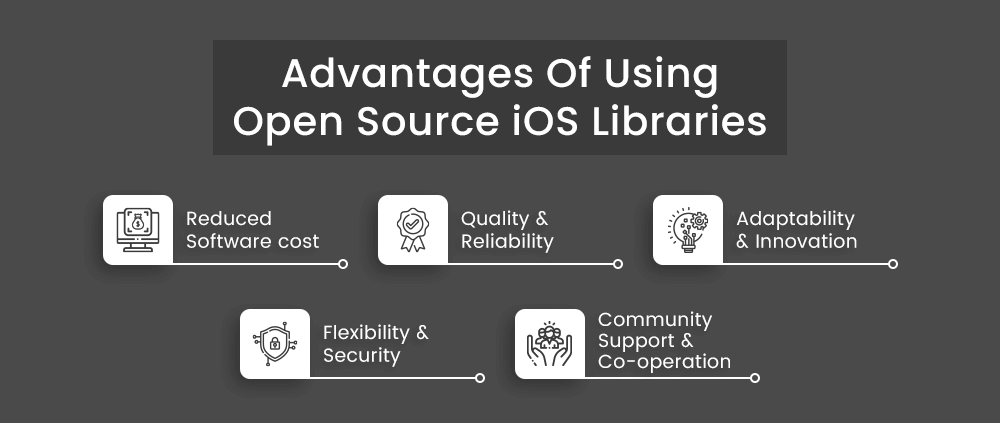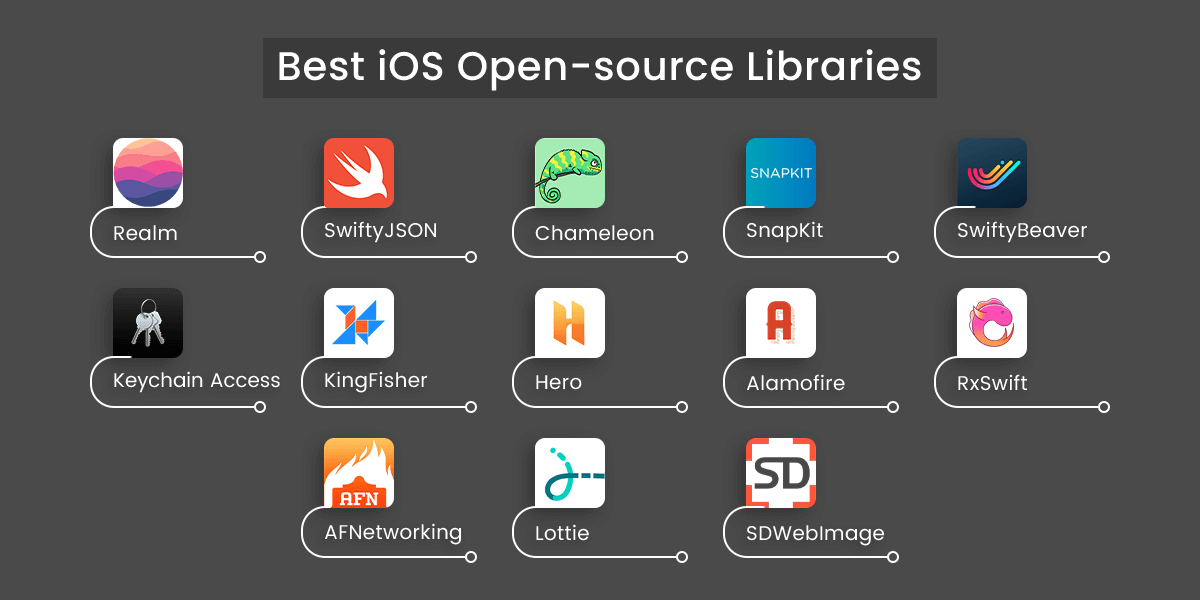Quick Summary:
With the quick changes that come with each new iOS release, development demands change, forcing us to reconsider the libraries we utilize. We’ve compiled a list of iOS open-source libraries that will aid in the development of your mobile app.
The increased popularity of smartphones has accelerated the development of mobile applications. Smartphones are no longer merely for making phone calls. They’re used for talking, sending, and receiving emails, communicating with people from other countries, using social media, ordering food, using e-commerce, and virtually anything else.
Today’s developers are constantly creating excellent apps for a wide range of areas. One of these domains is iOS. If you’ve worked with iOS App Development Company before, you know it’s not a simple task. Developers today have access to open-source iOS libraries that may be readily integrated into their projects.
Before delving into the subject further, let’s start by explaining what an Open-Source Library is.
What is Open Source Libraries?
The popularity of open-source software has exploded in recent years. In a nutshell, an open-source library is any library that has an open-source license. Without authorization, anybody can reuse, edit, or publish the code. Most open-source library software is available with a web interface and is licensed under the GNU General Public License.
OpenSource or Closed Source, which one to use?
The debate over whether to use a closed-source or open-source solution has always raged. This section will provide insight into some of the considerations you’ll need to make before making your ultimate decision.
Cost
One of the most significant differences between the two is the price. Closed software is paid software, whereas open-source libraries are free. Although open-source libraries are generally free, they may involve add-ons, assistance, or additional functionality fees. On the other hand, closed software offers superior support, functionality, and efficiency for a higher price.
Development
Closed source software’s investors are responsible for the development and problem patches, and it is up to them to decide whether or not to continue development. When it comes to open-source, the entire community is responsible for development. As a result, as long as the community is engaged, development and problem fixes will continue.
Usability
The lack of usability in free software is because usability experts do not examine the codes and are created for developers rather than laypeople. Furthermore, the written manuals are not clear and difficult to comprehend. Closed source software, on the other hand, has thorough and well-written documentation. Usability is the most important feature of closed or proprietary software, and experts evaluate the usability of these solutions.
Security
Let us discuss one of the most critical components: security. As the term implies, open-source is open to everybody, making it subject to security threats. The community can access, share, and modify the open-source code. This means that anyone can use the code to embed, upgrade, or test it. If the open-source code is intended to be used incorrectly, it is quite easy to do so.
Open Source Software v.s Proprietary Software Comparison Table
| Open Source Software | Proprietary Software |
| A source open and accessible for use to the general public | A software whose source code is protected & not available to the general public |
| Code can be changed by contributors or organizations | Only the individual or organization who created the software can change the code |
| No restrictions on users for usability and alteration of software | There are various restrictions on the user in terms of usability and alteration |
| It can be installed on any computer | Requires a legal license before installation |
| Open source can fail fast but can be fixed faster | It has no chance of failure |
| No one is responsible for open source software | The vendor is responsible for the software |
| Example: Firefox, OpenOffice, MySQL, PHP, Oerl, Samba, etc | Example: Skype, JAVA, Google earth, Microsoft Windows, etc |
Advantages of Using Open Source iOS Libraries

Organizations are turning towards open-source iOS libraries because of their quality, reliability, compatibility, efficiency, community support, and recent innovation.
Why create your program from the ground up when you can use an open-source library to do it much faster?
Reduced Software cost
Compared to traditional library systems, open-source solutions have a cheaper total cost of ownership because no licensing costs are required. Open source has no upfront costs; the only expenses would be for media, documentation, and support.
Quality & reliability
App developers prefer open-source libraries due to their technological simplicity. Thousands of experienced web and app developers create open-source libraries or software, and all users have access to the source code. This implies that anyone can study the library, correct problems, and improve its capabilities.
Adaptability & Innovation
Open-source iOS libraries can be thought of as the other name for innovation. Instead of waiting for the next upgrade or release, you may build and launch the features you need now. Anyone with interest in software development can add new functions or features to their projects. An open-source library lets you adapt code according to your specific requirements easily. The ability of customization and adjustment makes the open-source library and software a preferred choice for all.
Flexibility & Security
Another advantage of open-source software is its adaptability. The provided codes are not tied to a single developer and have a wide range of features. Users of open-source software can choose functionalities based on their individual needs by simply modifying the source code. In addition, the peer-review process ensures security and accountability.
Community Support & Co-operation
Open-source libraries foster communication, cooperation, and collaboration between specialists interested in technology because they are similar to an open platform where no one evaluates you and comments are welcomed.
The most widely used open-source iOS libraries are supported through online forums and support groups where like-minded professionals exchange their knowledge and learn from one another. These iOS open-source libraries are user-friendly since they are adaptable to any environment and structure and cost-effective. In the end, it’s all about how you use these libraries to meet your specific needs.
Now that we’ve seen the comparison and learned about all of the benefits that iOS open-source libraries bring let’s look at some of the most popular open-source iOS libraries on the market.
Best iOS Open-source Libraries

1. Realm
| Points | Stats |
| Github Stars | 14.6K |
| NPM Downloads (Weekly) | 13,565 |
| Price | Free |
| License | Apache-2.0 |
| Type of Support | Community Support via Github issues |
| Documentation | Full Documentation |
| Latest Update | 10.8.0 |
Realm is the most widely used open-source iOS library for developers, and it has established a platform for real-time data synchronization between apps. Relationships, generics, and vectorization are also supported. It is a mobile database that works on a variety of platforms and iOS, and it runs on phones, tablets, and wearables directly. It is intended to take the place of Core Data and SQLite. You receive a data browser to explore database files that are easier and faster to use.
Features of Realm
- Developer Intuitive
- Supports Offline Use
- Built for Mobile
- Object-Oriented
- Live Objects
- Fully encrypted
- Open Source
- Cross-platform
- Fast Querying &Data Sync
2. SwiftyJSON
| Points | Stats |
| Github Stars | 20.9K |
| Price | Free |
| License | MIT |
| Type of Support | Community Support via Github issues |
| Documentation | Full Documentation |
| Latest Update | 5.0 |
SwiftyJSON is one of the most popular iOS open-source libraries. It makes it easy for developers to cope with JSON data in Swift iOS easily. SwiftJSON makes testing JSON data easy which is difficult the other way around due to typecasting issues. By adapting SwiftyJSON
- You can no longer face old error types
- Can merge two JSON to another
- Can navigate through multiple levels only in one call
Features of SwiftyJSON
- Cleaner & Safer
- Lesser coding
- Swift and Objective C can be bridged
- Strictly for Swift
- Built-in error catching mechanism
3. Chameleon
| Points | Stats |
| Github Stars | 12.5K |
| Price | Free |
| License | MIT |
| Type of Support | Community Support via Github issues |
| Documentation | Full Documentation |
| Latest Update | 2.2.0 |
Originally developed by Vicc Alexander, the chameleon is the open-source, lightweight, powerful color framework for iOS. It works well with both Objective-c & Swift. The main aim of this ios opensource library is to make software perform seamlessly while maintaining its modern, beautiful interface. When you have the perfect design in mind and you don’t want to hassle RGB color values, the chameleon can save your time and adjust the right color combination.
Features of Chameleon
- 24 Flat colors
- contrast any text with its background
- Global App theming
- Easy ligten & Darken any color
- Generate colors from the image
- Gradient colors
- Xcode Documentation
- Color Scheme Support
- Storyboard Platette plugin
- Hex color support
4. SnapKit
| Points | Stats |
| Github Stars | 17.9K |
| Price | Free |
| License | MIT |
| Type of Support | Community Support via Github issues |
| Documentation | Full Documentation |
| Latest Update | 5.0.1 |
SnapKit is an open-source iOS Auto Layout library that makes it easy to develop auto layouts in code with the least code while preserving readability. It’s type-safe by default, which means it’ll help you avoid programming errors while you build your user interface.
let box = UIView()
let container = UIView()
container.addSubview(box)
box.snp.makeConstraints { make in
make.size.equalTo(50)
make.center.equalTo(container)
}When it comes to views with regularly changed constraints, it’s also quite useful. It’s a lot more fun to re-create constraints than it is to deal with Auto Layout by hand:
func updateBoxSize(to size: CGFloat) {
box.snp.remakeConstraints { make in
make.size.equalTo(size)
}
}
Features of SnapKit
- Simple & Expressive Chaining DSL
- Building Constraints With Minimal Amounts Of Code
- Easy To Read And Understand.
- Type-Safe
- Compatible For Both Ios And OS X Apps
- Installable Through Cocoapods Or Carthage.
- Open-Source
- Licensed Under The Flexible MIT License.
5. SwiftyBeaver
| Points | Stats |
| Github Stars | 5.3K |
| Price | Free |
| License | MIT |
| Type of Support | Community Support via Github issues |
| Documentation | Full Documentation |
| Latest Update | 1.9.5 |
SwiftyBeaver logging library is the extensible & lightweight open-source logger for swift 2.2 and later. This Xcode library is great for development & release due to its support for custom logging destinations. Swift Beaver framework is also an important foundation of Swiftbeaver logging platform, which includes:
Swifty Beaver Framework: to create logs in your app during development and release.
SwiftBeaver Crypto Cloud: store & Sync encrypted logs
SwiftBeaver Mac App: to download, search, analyze the logs sent from the app.
Features of SwiftyBeaver
- Log To Xcode Console
- Custom Log Destination
- End-To-End AES256 Encryption
- Colored Output
- Serial Background Queues/Threads
- Increase Productivity
- Easy & Convenient Configuration
- Multiple Logging Destinations Settings
- Already Comes With Good Defaults
- Fully Customizable Log Format
- Mighty Filters
- Use Log.Debug(“Foo”) Syntax
- Detailed Logging
- Simple Installation Via Carthage, Cocoapods, Swift Package Manager, Or Download
- Native Support For Leading Xcode Development Plugins
6. Keychain Access
| Points | Stats |
| Github Stars | 6.5K |
| Price | Free |
| License | MIT |
| Type of Support | Community Support via Github issues |
| Documentation | Full Documentation |
| Latest Update | 4.2.2 |
Keychain Access is a simple Swift wrapper for a keychain that works in iOS and macOS. It makes using Keychain API extremely easy and saving and retrieves data from the keychain.
// Save to the keychain
let valueToSave = "Important data"
Keychain().set(valueToSave, key: "key")
// Get from keychain
let saved value = try? Keychain().get("key")Features of Keychain Access
- Simple interface
- Support access group
- Support accessibility
- Support iCloud sharing
- Support TouchID and Keychain integration (iOS 8+)
- Support Shared Web Credentials (iOS 8+)
- Works on both iOS & macOS
- watchOS and tvOS are supported
- Mac Catalyst is supported
- Swift 3, 4, and 5 compatible
7. KingFisher
| Points | Stats |
| Github Stars | 19.1K |
| Price | Free |
| License | MIT |
| Type of Support | Community Support via Github issues |
| Documentation | Full Documentation |
| Latest Update | 7.0.0 |
Next on the list of iOS Open-source libraries is Kingfisher. It’s a robust, all-in-one package for obtaining and caching web pictures. It will fetch the image from the URL, save it to the memory and disc caches, then show it in a UIImageView, NSImageView, NSButton, or UIButton. When you try to retrieve an image with the same URL later, it will be pulled from the cache and displayed right away.
// Basic version
let url = URL(string: "https://example.com/image.png")
imageView.kf.setImage(with: url)
// SwiftUI version
import KingfisherSwiftUI
var body: some View {
KFImage(URL(string: "https://example.com/image.png")!)
}
It also comes with several useful extra features, like the ability to display a system indicator and a placeholder picture while downloading, built-in updating transitions, extensible image processing and formatting, and much more.
Features of KingFisher
- Asynchronous image downloading and caching.
- Load images from URLSession-based networking or locally.
- Useful image processors and filters were provided.
- Multiple-layer hybrid cache.
- Customizable expiration date and size limit.
- Cancelable downloading.
- Auto-reusing content to improve performance.
- Independent components.
- Prefetching images to boost your app.
- Built-in transition animation.
- Customizable placeholder and indicator.
- Extensible image processing.
- Low Data Mode support.
- SwiftUI support.
8. Hero
| Points | Stats |
| Github Stars | 20.4K |
| Price | Free |
| License | MIT |
| Type of Support | Community Support via Github issues |
| Documentation | Full Documentation |
| Latest Update | 1.6.1 |
Hero is a library for creating transitions between iOS view controllers. It adds a declarative layer to the UIKit’s onerous transition APIs, making it simple to create unique transitions. All source and destination views are checked for the heroin property. Each matched view pair is then converted from its previous state to its new state automatically.
In addition, the hero can create animations for unrivaled vistas. The heroModifiers property makes defining these animations simple. These animations will be played with the magic move animations by the hero. All of these animations can be controlled interactively using user gestures.
// First viewController - VC1
redView.hero.id = "ironMan"
blackView.hero.id = "batMan"
// Second viewController - VC2
self.hero.isEnabled = true
redView.hero.id = "ironMan"
blackView.hero.id = "batMan"
whiteView.hero.modifiers = [.translate(y: 100)]
As you can see, Hero does a lot of heavy lifting to provide us with a simple API to create powerful animations.
Features of Hero
- Match
- Scale
- Arc
- Cascade
- Translate
- Rotate
- Interactive
- Dynamic
9. Alamofire
| Points | Stats |
| Github Stars | 36.4K |
| Price | Free |
| License | MIT |
| Type of Support | Community Support via Github issues |
| Documentation | Full Documentation |
| Latest Update | 5.4.4 |
Alamofire is a simple and modular means of interacting with HTTP network requests. This swift networking library is built on top of the Foundation framework’s URL Loading System, which Apple offers. The URLSession and URLSessionTask subclasses are at the heart of the system. This swift HTTP library covers these APIs and many more in a user-friendly interface and provides a wide range of features for modern HTTP networking application development.
Features of Alamofire
- Chainable Request/Response Methods
- Combine Support
- URL/JSON Parameter Encoding
- Upload File/Data/Stream/ MultipartFormData
- Download File using Request/Resume Data
- Authentication with URLCredential
- HTTP Response Validation
- Upload and Download Progress Closures
- CURL Command Output
- Dynamically Adapt and Retry Requests
- TLS Certificate & Public Key Pinning
- Network Reachability
- Comprehensive Unit & Integration Test Coverage
- Complete Documentation
10. RxSwift
| Points | Stats |
| Github Stars | 20.9K |
| Price | Free |
| License | MIT |
| Type of Support | Community Support via Github issues |
| Documentation | Full Documentation |
| Latest Update | 6.2.0 |
Next on the list is RxSwift and RxCocoa for iOS open-source libraries. Rx has been rewritten in Swift, and it strives to port as many principles as possible from the original version. Still, some of them have been tweaked for a more comfortable and efficient interface with the iOS/macOS environment.
Like the original Rx, its goal is to make composing asynchronous actions and event/data streams simple. Under the abstraction of sequence, KVO observing, async operations, and streams are all unified. Rx is so simple, elegant, and strong because of this.
Here’s a simple example of how RxSwift may be used to develop logic for activating a login button that checks two things: whether the username and password are both typed and whether the password is of sufficient length.
let name = nameTextField.rx.text.asDriver()
let password = passwordTextField.rx.text.asDriver()
let isEnabled = Driver
.combineLatest(
name,
password
) { !$0.isEmpty && $1.count >= 6 }
isEnabled
.drive(loginButton.rx.isEnabled)
.disposed(by: disposeBag)
RxSwift/RxCocoa is only scraping the surface here, but you can already see how it can make your life easier. RxSwift has a longer learning curve than other libraries you may use in your applications, but once you figure it out, you’ll be glad you did and won’t look back.
Features of RxSwift
- Async Operations
- Map/Filter
- Cache Invalidation
- Cross-Platform
- Blocking Operators For Unit Testing
- Lockless Single Sequence Operators (Map, Filter)
- Unified Hot And Cold Observables
- Refcount
- Concurrent Schedulers
- Generated Optimized Narity Operators (Combine Latest, Zip)
- Reentrant Operators
11. AFNetworking
| Points | Stats |
| Github Stars | 33.3K |
| Price | Free |
| License | MIT |
| Type of Support | Community Support via Github issues |
| Documentation | Full Documentation |
| Latest Update | 4.0.1 |
This is one of the most commonly used iOS networking libraries for mobile apps, and it has a fantastic community of iOS developers who contribute to it daily.
It’s an Objective-C iOS third-party library for tvOS and macOS that’s open source. AFNetworking has it all, from fundamental to advanced capabilities like SSL Pinning and Network Reachability. You have the benefit of outstanding design and extensive testing thanks to its undeniable success (50 million downloads). Working with it is made easier by the various plugins and extensive documentation available.
Features of AFNetworking
- Supports all NSURLSession
- Provides Serialization
- Reachability Support
- Security policy management
- Uikit Integration
12. Lottie
| Points | Stats |
| Github Stars | 22K |
| NPM Downloads (Weekly) | 145,286 |
| Price | Free |
| License | Apache-2.0 |
| Type of Support | Community Support via Github issues |
| Documentation | Full Documentation |
| Latest Update | 3.2.3 |
Lottie is one of the best swift animation libraries. Animations enhance the user experience by capturing attention and promoting a business engagingly and intuitively. Lottie accomplishes something quite remarkable. Because creating animations with UIView or CoreGraphics is a burden for developers. This iOS animation library comes with a toolkit to incorporate gorgeous designer’s works into your program.
The body moving JSON format is used to load and render animations and vectors in this Airbnb creation. Adobe After Effects is straightforward to parse using Lottie, allowing you to create far better and more enjoyable software.
Features of Lottie
- Small size animation file
- Vector Format
- No impact on app performance
- Will brush up on your UI
- Plugins are available for free
- Makes your app more appealing
13. SDWebImage
| Points | Stats |
| Github Stars | 23.8K |
| Price | Free |
| License | MIT |
| Type of Support | Community Support via Github issues |
| Documentation | Full Documentation |
| Latest Update | 5.11.1 |
SDWebImage is the most popular swiftui library. It is lightweight and quick, including an asynchronous image downloader and cache support, as well as handy UIKit categories for tasks like setting a UIImageView picture to a URL.
The simple job of setting an image view to an image using a URL hasn’t gotten any easier in Cocoa, even though networking has grown much easier. SDWebImage is the best iOS development library since it simplifies the procedure to a large extent.
Features of SDWebImage
- Categories for UIImageView, UIButton, MKAnnotationView
- An asynchronous image downloader
- Asynchronous memory and disk image caching
- Automatic cache expiration handling
- Background image decompression
- Progressive image loading
- Thumbnail image decoding
- Extendable image coder(Support for WebP)
- Full-stack solution for animated images
- Customizable & composable image transformations
- Customizable and multiple caches system
- Customizable and multiple loaders systems
- Image loading indicators
- Image loading transition animation
- Same URL won’t be downloaded several times
- Bogus URLs won’t be retried again and again
- Main thread will never be blocked
- Modern Objective-C & better Swift Support Performances
iOS Open-Source Libraries Usage Checklist
When using iOS third-party libraries, there are some things to keep in mind and let’s take a look at them.
- Before we start the list, I’d like to stress the importance of using third-party libraries appropriately.
- Check to see if the libraries you’ll be using are regularly developed and supported.
- Working on a project a year or two down the road could be problematic if it stops compiling at some point due to a Swift or iOS change that breaks utilized libraries.
Wrapping Up
iOS developers are experiencing a period of intense competition as Apple’s technology advances. The market will ruthlessly eliminate traditional and out-of-date programmers and coders. To solve intelligent problems, you must think wisely. iOS Open-source Libraries are solely intended to assist you in honing your skills.
To stay at the top of this extremely competitive field, you must only use the best ios libraries. Therefore, using the ios list of libraries provided above, you can choose the finest open-source iOS library according to your requirements to get the best exposure possible.
Also Check:





 Say
Say